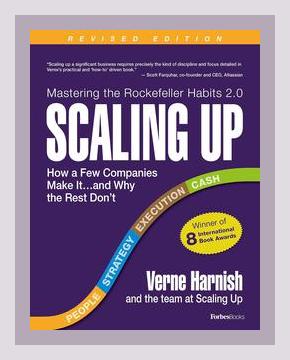Entrepreneurship and StartupsInnovation and CreativityTech StartupsBusiness Model Innovation
**
Introduction
“Scaling Up” by Verne Harnish, published in 2014, is a comprehensive guide for tech startups and businesses aiming to grow efficiently and sustainably. The book provides a wealth of practical strategies, frameworks, and tools designed to help businesses navigate the complexities of scaling. It rests on four key decision areas: People, Strategy, Execution, and Cash.
1. People: Building a Winning Team
Key Points
A. Right People in the Right Seats
Harnish emphasizes the importance of having the right people in the right roles. The concept is derived from Jim Collins’ “Good to Great” and is crucial for building a foundation that can support growth.
- Action Step: Regularly evaluate team members to ensure they are in roles that match their strengths. Use tools like Topgrading for assessing candidates’ compatibility.
B. Creating a Healthy Culture
A robust organizational culture can drive business success. Culture isn’t just about values on a wall but is reflected in behavior and decision-making processes.
- Action Step: Conduct regular cultural assessments and realign organizational practices to uphold core values. Implementing weekly or bi-weekly culture meetings can help embed these values.
C. Leadership Development
Investing in leadership development ensures that as the company scales, there is a consistent pipeline of capable leaders.
- Action Step: Create a leadership development program, including mentorship and training sessions. Encourage continuous learning through resources such as business books, courses, and seminars.
Examples from the Book
Southwest Airlines – Demonstrated how having the right people and a strong cultural fit helped them maintain operational efficiency and customer satisfaction even during tough times.
2. Strategy: Creating a Vivid Vision
Key Points
A. One-Page Strategic Plan (OPSP)
Simplifying the company’s strategy on one page can help keep the entire organization aligned.
- Action Step: Use the One-Page Strategic Plan template to distill your vision, values, and long-term goals. Review and update this plan quarterly.
B. Core Values, Purpose, and BHAG (Big Hairy Audacious Goal)
Identifying and communicating core values and purpose provides a guiding star for decision-making and helps engage employees.
- Action Step: Conduct workshops to define core values and purpose. Formulate a BHAG that challenges the organization to aspire towards significant achievements.
C. Differentiation and Brand Promise
Standing out in the market requires a clear understanding of how your product or service is different from competitors.
- Action Step: Use customer feedback and competitive analysis to identify your unique selling proposition (USP). Adjust your marketing and product strategies to reflect this differentiation.
Examples from the Book
Apple – Their BHAG was to “make a dent in the universe.” This overarching goal inspired innovation that defined the company’s strategy.
3. Execution: Driving Operational Excellence
Key Points
A. Rockefeller Habits Checklist
Harnish introduces the Rockefeller Habits Checklist to ensure disciplined and consistent execution.
- Action Step: Implement daily, weekly, monthly, and quarterly meetings to maintain focus on strategic priorities. Use a scoreboard to track progress.
B. Priority Setting
Establishing clear priorities at all organizational levels helps ensure everyone is working towards common goals.
- Action Step: Set 3-5 priorities for the company each quarter. Align team and individual goals with these priorities to encourage focused effort.
C. Data-Driven Management
Using key metrics to guide decision-making can significantly improve execution effectiveness.
- Action Step: Develop an organizational dashboard that includes critical metrics, such as customer satisfaction, financial performance, and operational efficiency. Review these metrics in leadership meetings.
Examples from the Book
Atlassian – Used regular company-wide meetings and transparency in goal-setting to foster a culture of accountability and excellence in execution.
4. Cash: Managing Finances Effectively
Key Points
A. Cash is King
Cash flow management is crucial for any scaling business. Having ample cash on hand can buffer against unexpected expenses and enable strategic investments.
- Action Step: Conduct regular cash flow forecasts to anticipate financial needs. Implement cost control measures and maintain a cash reserve.
B. The Power of One
One critical performance measure can influence others. For instance, focusing on reducing the time to cash helps improve overall cash flow.
- Action Step: Identify one metric (e.g., accounts receivable days) that has the most substantial impact on financial performance and focus on improving it.
C. Profitability and Cash Conversion Cycle
Understanding and optimizing the cash conversion cycle (CCC) can significantly enhance financial health.
- Action Step: Analyze and streamline processes related to inventory management, customer payments, and supplier terms to shorten the CCC.
Examples from the Book
Dell – Implemented strategies to reduce their cash conversion cycle, freeing up millions in cash to reinvest in growth.
Conclusion
“Scaling Up” by Verne Harnish is a critical read for anyone involved in tech startups or business model innovation looking to scale their operations. The book’s structured approach on People, Strategy, Execution, and Cash provides a practical and actionable framework to drive growth.
Implementing Tools and Tips:
– Perform regular evaluations and cultural assessments to maintain a healthy work environment.
– Create and regularly update a One-Page Strategic Plan to keep everyone aligned with the company’s vision and objectives.
– Use the Rockefeller Habits Checklist to ensure disciplined execution.
– Focus on critical cash flow metrics and optimize the cash conversion cycle to maintain financial health.
By following these steps and integrating the suggested examples and practices, businesses can surmount the scaling challenges and achieve substantial growth.
Entrepreneurship and StartupsInnovation and CreativityTech StartupsBusiness Model Innovation
